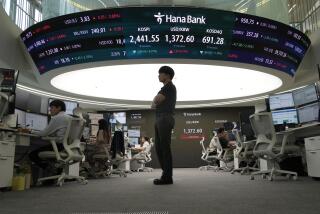Soldiers to Help Ease Labor Pinch in South Korea : Economy: The draftees will work at small firms. Meanwhile, the government wrestles with whether to let in foreign workers.
- Share via
SEOUL — Faced with a serious imbalance in the labor market, the South Korean government has decided to place military conscripts in civilian jobs at small companies.
Beginning Sept. 1, draftees exempted from regular army service but required to perform auxiliary military duties will be allowed to sign up for five years of work in factories, on construction jobs or as merchant seaman, said Ahn Hee Won, director of manpower planning at the Economic Planning Board.
By year’s end, the government hopes to sign up 4,000 draftee-workers. Next year, officials hope that 10,000 to 15,000 conscripts will be deployed in the civilian labor force.
Only companies with 300 or fewer employees will be allowed to hire draftees, but even so demand will exceed supply, the Korea Chamber of Commerce and Industry estimated. The group reported that 1,000 small firms among its members hoped to employ 21,500 draftees. Including non-member companies, the chamber estimated that demand would exceed 30,000.
Throughout the country, the Labor Ministry estimates a shortfall of 192,000 workers to perform existing jobs.
Ahn and other officials say they do not envision the new system spurring trade complaints from abroad. But many of the small firms are engaged in exporting or serve as suppliers to larger firms that export, a situation that may raise questions in the United States and elsewhere.
Draftees’ pay will be the same as that of regular employees of the firms that hire them, Ahn said. A private first class in the Korean army earns only $10.83 a month, while factory wages average $820 a month.
No coercion will be involved, Ahn contended. Reserve conscripts will be free to choose whether to perform low-pay military duty for 18 months or civilian-pay private-industry jobs for five years, he said.
There will be one difference, however. As members of the armed forces, draftees will be barred from joining or organizing labor unions, even though the small firms that will be eligible to hire them offer wages and working conditions far worse than the private-industry average. “It’s only natural that soldiers can’t join unions,” Ahn said.
A U.S. Embassy official noted that many American laws contain provisions banning imports from countries that restrict labor rights, “including the right to organize.” The Korean move “is a bit unusual, and it’s something that will get very close scrutiny not only by the United States but by other countries as well,” said the official, who asked not to be identified.
Ahn explained that military workers would be drawn from a special category of draftees called “reserve conscripts.” They are men who are physically unfit for regular military service or who failed to graduate from junior high school, as well as men who are the sole male offspring of fathers who had no brothers.
The number of reserve conscripts who perform jobs such as clerks or messengers at military bases or at government offices is a military secret, Ahn said. Military service is an obligation for all Korean men. Regular army draftees must serve 2 1/2 years.
Ahn said the attraction of choosing civilian work over auxiliary military jobs would come from the higher pay and the chance to learn skills. Draftees also would be able to assume regular employment at the firms that hire them after their military obligation ends, he added.
South Korea is taking such extraordinary measures at a time when economic planners are reassessing the nation’s labor needs.
With an extremely young work force--about 27% of the nation’s 42.9 million people are students, from elementary school to the graduate level--planners had assumed for decades that South Korea’s gross national product needed to grow in real terms by 6% a year just to create jobs for new entrants into the labor force.
“But those days ended three or four years ago,” said Kim Han Eung, chief of the Bank of Korea’s statistics department.
Indeed, Kim’s department just issued results of a study stressing the need to constrain growth.
The bank said Korea could fill the demand for a 2.2%-per-year increase in the labor force that a 7% annual growth rate would create by raising the retirement age--now 61 in government and 55 in private industry--and employing more women.
Only once in recent years, however, has the economy expanded by 7% or less. Growth last year and this year is at 9%--a rate that the bank warned would increase demand for labor by 4.1% a year.
The bank warned that if South Korea’s economy continued to expand by more than 7% annually, a labor shortage would hit the country in nine years, perhaps forcing it to import unskilled foreign labor. “We want to preserve our national ethics,” Kim said.
Despite South Korea’s racial homogeneity and antipathy toward foreigners, small factories, construction companies, merchant marine firms and coal mine operators have started advocating that foreign workers be brought in. The calls precipitated a debate that reached the Cabinet in March. It decided to reject foreign labor, although it left open for more debate whether to allow foreign coal miners.
Both the Labor Ministry and the Energy and Natural Resources Ministry favor importing miners. The Construction Ministry is continuing to seek an exception. And the Ministry of Trade and Industry recently urged that rules governing foreign trainees be changed to allow all small companies--those with five to 300 employees--to use foreign “trainees” to fill up to 5% of their work force.
Already, the first ripple of foreign workers has appeared. Some 4,000 foreigners who were admitted as trainees are being used as factory hands, Ahn said, adding that several thousand others are working illegally on tourist visas.
Women--who under Confucian ethic have been taught that their role is in the home--also have become a key target of the government effort to find more workers. “Standards are changing,” said Cho Soon Moon, director of the employment security bureau at the Labor Ministry, citing a 6% increase--to 48%--in the percentage of working women, including farm wives, the last seven years. Cho said the ministry is promoting the establishment of more day-care centers to encourage women workers.
Ironically, the government has contributed to the labor pinch.
In the early 1980s, former President Chun Doo Hwan more than doubled the number of students that junior colleges and universities could accept. That move expanded enrollment to nearly 1.4 million from 565,000 in 1980 and “drastically limited the economically active population,” Ahn noted.
More recently, an increase in land and housing costs induced the government of President Roh Tae Woo to implement a dramatic plan to build 2 million housing units in four years. The plan is expected to achieve its goal of reining in housing costs. But it also has created a shortage of construction workers and driven pay in the industry through the roof.
Construction workers last year were paid a monthly average of 745,000 won ($1,035), compared to $820 in manufacturing jobs, a Labor Ministry survey showed. Pay for specialists, such as plumbers, was estimated at three times the average for manufacturing jobs. Still, construction firms face a shortage of nearly 7,000 workers, Cho said, adding that manufacturing firms, particularly those in textiles and metal and machinery assembly, suffer the biggest shortage--nearly 150,000 workers.
More to Read
Sign up for Essential California
The most important California stories and recommendations in your inbox every morning.
You may occasionally receive promotional content from the Los Angeles Times.










